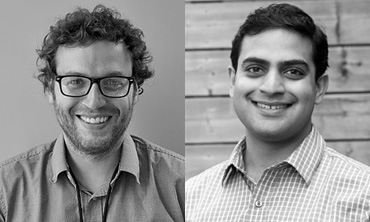Making meaning out of data

By Ana Gajic

Josh Murray and Dr. Amol Verma
Imagine if a simple tool could help organizations predict the future. Hospital leaders could see upcoming patient volumes and their acuity levels and businesses could predict supply needed to meet a demand.
That’s exactly what a new tool created by the Li Ka Shing Centre for Healthcare Analytics and Training (LKS-CHART) can do. The St. Michael’s Hospital based research team has created a tool that can analyse historic time series to forecast future data.
“We designed it so that anybody could do this kind of sophisticated analysis very quickly,” said Josh Murray, senior data scientist at LKS-CHART. “It usually takes a lot of coding and a lot of time to do this kind of work. The tool allows us to do it in a few minutes.”
Most recently, the LKS-CHART team used the tool to examine the accuracy of estimates of deaths in Puerto Rico after the recent hurricane by a team of researchers from Harvard University. The LKS-CHART tool corroborated the findings, and a letter on their work has been published today in the New England Journal of Medicine.
“The death toll after a natural disaster is hard to measure,” said Dr. Amol Verma, a researcher at the Li Ka Shing Knowledge Institute and a physician at St. Michael’s. “A Harvard-led team conducted a sophisticated survey-based study to measure death rates after Hurricane Maria, but their ultimate conclusions rested on a few key assumptions. We used our forecasting tool to test a key assumption in that study and came back with an answer in a day, as opposed the weeks it might normally take to conduct this level of analysis.”
The tool is currently in use at St. Michael’s in select units, and since the LKS-CHART has made it open access online, institutions across Canada and the United States have adopted the tool for various opportunities.
In health care in particular, knowing when there might be higher patient levels in the hospital, or higher demands for blood products based on past patterns could reduce waste and increase efficiency. And, it could help answer pressing public health concerns, as the team demonstrated in the NEJM.
“What’s exciting about this recent publication is that it demonstrates our in-house developed tool can contribute at the very highest levels of science,” Dr. Verma said. “It shows that our team at St. Michael’s is helping to make meaning out of data.”
Dr. Muhammad Mamdani, director of LKS-CHART, hopes the publication will encourage more people to use the technology.
“Our forecasting tool is freely available online for researchers, and we invite people to use it,” he said.
About St. Michael’s Hospital
St. Michael’s Hospital provides compassionate care to all who enter its doors. The hospital also provides outstanding medical education to future health care professionals in more than 29 academic disciplines. Critical care and trauma, heart disease, neurosurgery, diabetes, cancer care, care of the homeless and global health are among the Hospital’s recognized areas of expertise. Through the Keenan Research Centre and the Li Ka Shing International Healthcare Education Centre, which make up the Li Ka Shing Knowledge Institute, research and education at St. Michael’s Hospital are recognized and make an impact around the world. Founded in 1892, the hospital is fully affiliated with the University of Toronto.
St. Michael’s Hospital with Providence Healthcare and St. Joseph’s Health Centre now operate under one corporate entity as of August 1, 2017. United, the three organizations serve patients, residents and clients across the full spectrum of care, spanning primary care, secondary community care, tertiary and quaternary care services to post-acute through rehabilitation, palliative care and long-term care, while investing in world-class research and education.
